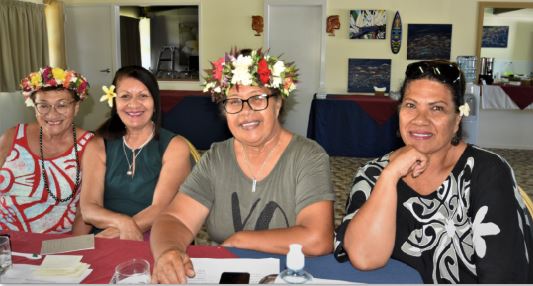Cooks proactively conserving biodiversity
Wednesday 25 January 2023 | Written by Supplied | Published in Environment, National

Rongo Preston (left), Noeline Browne, Philomen Williams and Ina Karika-Anae attended the Other Effective Area-based Conservation Measures (OECMs) workshop. 23012407
Committed to achieving 25 per cent of our land as a Protected Area in the Cook Islands under the Cook Islands NSDA2020+, our island nation is exploring new ways to do this.
This further helps our island nation meet global obligations as agreed in the post-2020 Global Biodiversity Framework (GBF) to both halt and reverse biodiversity loss.
Human activity has resulted in the extinction of one million plant and animal species, but despite that over half of the worlds GDP is reliant on our environment.
Endorsed in December 2022, the GBF has 23 targets under four overarching goals to be met by over 195 countries including the Cook Islands. Target three is in line with our goals under the Cook Islands National Sustainable Develop Plan 2020-Plus.
This focusses on ensuring that 30 per cent of areas of particular importance are protected and effectively conserved and managed by 2030. The Cook Islands also supported the High Ambition Coalition for Nature and People that called for 30 per cent of protected areas on land and sea to conserve nature.
The Cook Islands is exploring Other Effective Area-based Conservation Measures (OECMs) through a two-day workshop that brings together a wide range of stakeholders to learn more about this concept. OECMs are not Protected Areas, but are geographically defined areas that are governed and managed in ways that sustain positive and sustained long-term conservation.
“We are excited by the opportunities that OECMs will bring, we look forward to reviewing the value of these in the Cook Islands.
They will enable and empower our local communities that are currently conserving areas either on land or in our waters, to be acknowledged for their work and environment achievements hopefully leading to further support,” said Halatoa Fua, Director of the Cook Islands National Environment Service.
“We all know the value of our Protected Areas, this goes beyond a financial cost to that which helps sustain our wellbeing be it sustainable water resourcing, food security, supporting our Cook Islands economies and uplifting our Cook Islands culture. OECMs are one way that we can all work together at all levels to invest and increase this value in our island nation.”
The primary difference between OECMs and Protected Areas is that for OECMs, biodiversity conservation and protection may not always be their primary objective, however they deliver benefits for biodiversity conservation regardless.
Although it is anticipated that many areas within the Pacific could be designated as an OECM, there are currently none reported in the region. The two days ahead will bring Cook Islands stakeholders together to discuss the possible benefits and drawbacks of recognising and reporting these areas and learn about tools and assistance available. In addition to supporting the Cook Islands, it is anticipated that this could provide valuable lessons for other countries in the region interested in OECM identification, recognition, and support.
The workshop held on 24 and 25 January will result in an improved understanding of OECMs among conservation practitioners and policymakers, gain an insight into potential OECMs and concerns specific to the Cook Islands and the Pacific region. It will also help plan a way forward to recognise and report OECMs in the Cook Islands.
“When it comes to biodiversity, as a global community we are failing. Our marine species are impacted by marine plastic pollution which has increased tenfold since 1980, in the last 20 years our planet has lost approximately 420 million hectares of forest, and invasive species has been the cause of close to 40 per cent of all animal extinctions,” said Fua.
“What is happening across our planet is happening here to us also, and we’re pleased to be playing a proactive role to protect and conserve. The Cook Islands are taking the right, positive steps, doing what we can to provide solutions for this global crisis.”
Established Protected Areas in the Cook Islands include the Suwarrow National Park and 50 nautical miles around each island of the Cook Islands under the Marae Moana Act 2017 Section 24.
The Cook Islands Other Effective Area-based Conservation Measures (OECM) Workshop is held at the Edgewater Resort.
The workshop is supported by the EU-OACPS BIOPAMA programme and its partners – IUCN Oceania, the Secretariat of the Pacific Regional Environment Programme (SPREP) and the UN Environment Programme -World Conservation Monitoring Centre (UNEP-WCMC) in partnership with the Cook Islands National Environment Service.
>Media Release




















































